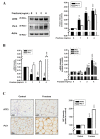Benefits of Valsartan and Amlodipine in Lipolysis through PU.1 Inhibition in Fructose-Induced Adiposity
- PMID: 36145135
- PMCID: PMC9502698
- DOI: 10.3390/nu14183759
Benefits of Valsartan and Amlodipine in Lipolysis through PU.1 Inhibition in Fructose-Induced Adiposity
Abstract
High fructose intake has been implicated in obesity and metabolic syndrome, which are related to increased cardiovascular mortality. However, few studies have experimentally examined the role of renin-angiotensin system blockers and calcium channel blockers (CCB) in obesity. We investigated the effects of valsartan (an angiotensin II receptor blocker) and amlodipine (a CCB) on lipolysis through the potential mechanism of PU.1 inhibition. We observed that high fructose concentrations significantly increased adipose size and triglyceride, monoacylglycerol lipase, adipose triglyceride lipase, and stearoyl-CoA desaturase-1 (SCD1), activating transcription factor 3 and PU.1 levels in adipocytes in vitro. Subsequently, PU.1 inhibitor treatment was able to reduce triglyceride, SCD1, and PU.1 levels. In addition, elevated levels of triglyceride and PU.1, stimulated by a high fructose concentration, decreased with valsartan and amlodipine treatment. Overall, these findings suggest that high fructose concentrations cause triacylglycerol storage in adipocytes through PU.1-mediated activation. Furthermore, valsartan and amlodipine treatment reduced triacylglycerol storage in adipocytes by inhibiting PU.1 activation in high fructose concentrations in vitro. Thus, the benefits of valsartan and amlodipine in lipolysis may be through PU.1 inhibition in fructose-induced adiposity, and PU.1 inhibition might have a potential therapeutic role in lipolysis in fructose-induced obesity.
Keywords: PU.1; activating transcription factor 3; adiposity; calcium channel blocker; fructose; renin–angiotensin system blocker.
Conflict of interest statement
The authors declare no conflict of interest.
Figures




Similar articles
-
Combination angiotensin-receptor blocker (ARB)/calcium channel blocker with HCTZ vs the maximal recommended dose of an ARB with HCTZ in patients with stage 2 hypertension: the exforge as compared to losartan treatment in stage 2 systolic hypertension (EXALT) study.J Clin Hypertens (Greenwich). 2011 Aug;13(8):588-97. doi: 10.1111/j.1751-7176.2011.00492.x. Epub 2011 Jul 14. J Clin Hypertens (Greenwich). 2011. PMID: 21806769 Free PMC article. Clinical Trial.
-
Efficacy of fixed-dose combination therapy in the treatment of patients with hypertension: focus on amlodipine/valsartan.Clin Drug Investig. 2010;30(9):625-41. doi: 10.2165/11538440-000000000-00000. Clin Drug Investig. 2010. PMID: 20626210 Review.
-
The N-type and L-type calcium channel blocker cilnidipine suppresses renal injury in Dahl rats fed a high-salt diet.Heart Vessels. 2010 Nov;25(6):549-55. doi: 10.1007/s00380-010-0005-4. Epub 2010 Oct 5. Heart Vessels. 2010. PMID: 20922532
-
Disparate effects of angiotensin II antagonists and calcium channel blockers on albuminuria in experimental diabetes and hypertension: potential role of nephrin.J Hypertens. 2003 Jan;21(1):209-16. doi: 10.1097/00004872-200301000-00031. J Hypertens. 2003. PMID: 12544453
-
Amlodipine/valsartan single-pill combination: a review of its use in the management of hypertension.Am J Cardiovasc Drugs. 2009;9(5):309-30. doi: 10.2165/11201120-000000000-00000. Am J Cardiovasc Drugs. 2009. PMID: 19791840 Review.
Cited by
-
New Insights into High-Fat Diet with Chronic Diseases.Nutrients. 2023 Sep 18;15(18):4031. doi: 10.3390/nu15184031. Nutrients. 2023. PMID: 37764814 Free PMC article.
-
Assessing the impact of concurrent high-fructose and high-saturated fat diets on pediatric metabolic syndrome: A review.World J Clin Pediatr. 2024 Jun 9;13(2):91478. doi: 10.5409/wjcp.v13.i2.91478. eCollection 2024 Jun 9. World J Clin Pediatr. 2024. PMID: 38947987 Free PMC article. Review.
References
MeSH terms
Substances
Grants and funding
LinkOut - more resources
Full Text Sources
Medical

